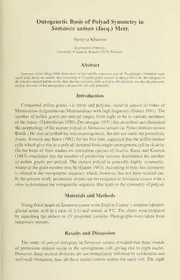
Ontogenetic basis of polyad symmetry in Samanea saman (Jacq.) Merr PDF
Preview Ontogenetic basis of polyad symmetry in Samanea saman (Jacq.) Merr
Ontogenetic Basis of Polyad Symmetry in Samanea saman (Jacq.) Merr. Surayya Khatoon DepartmentofBotany, UniversityofKarachi. Karachi-75270. Pakistan. Abstract Samaneasaman(Jacq.)Merr.bearsmoreorlessradiallysymmetricpolyad.Thepolyadisformedbyeight equalsized,decussatetetrads,thusconsistingof32pollengrainsintotal. Inthepresentwork,theontogenyof thepolyadisstudiedandtheresultsshowthatthesymmetryofthepolyadiseffectedbythefactthatthepremeiotic nucleardivisions inthe sporogenouscell precedecell-wall formation. Introduction Compound pollen grains, i.e. tetras and polyads. occur in almost all tribes of Mimosaceae (Leguminosae-Mimosoideae) with high frequency (Guinet 1981). The number of pollen grains per polyad ranges from eight to 64 in various members ofthe family (Maheshwari 1950). Dnyansagar (1951) has described and illustrated the morphology ofthe mature polyad ofSamanea saman (as Pithecolobiwn saman Benth.) He also described the microsporogenesis. but did not study the premeiotic events. Kenrick and Knox ( 1982) forthe first time suggested that the pollen mother cells which give rise to a polyad. descend froin single sporogenous cell inAcacia. On the basis of their studies on Australian species ofAcacia. Knox and Kenrick (1983) concluded that the number of premeiotic mitoses determined the number of pollen grains per polyad. The mature polyad is generally highly symmetric, whateverthe grain numbermay be (Guinet 1983).According to him. this symmetry is related to the ontogenetic sequence which, however, has not been worked out. In the present work, premeiotic events are investigated in Samanea saman with a view to determine the ontogenetic sequence that leads to the symmetry ofpolyad. Materials and Methods Young floral heads ofSamanea saman were fixed in Camoy's solution (ethanol- glacial acetic acid in a ratio of 3:1) and stored, at 5°C. The slides were prepared by squashing the anthers in \9c propionic carmine. Photographs were taken from temporary mounts. Results and Discussion The study of polyad ontogeny in Samanea saman revealed that three rounds of premeiotic mitosis occur in the sporogenous cell, giving rise to eight nuclei. However, these nuclear divisions are not immediately followed by cytokinesis and well-wall formation, thus all these nuclei remain within the same cell. The eight 204 nuclei are arranged in a circle near the periphery of the cell at almost equal distances from one another (Fig. 1A); then radial walls are laid down and a group of eight pollen mother cells is formed (Fig. IB). This group of radially arranged pollen mother cells undergoes meiosis and gives rise to the polyad, which consists of eight radially arranged decussate tetrads (Fig. 2A & 2B). Dnyansagar (1951) has described these tetrads as tetrahedral, but according to the terminology of Maheshwari (1950), these tetrads are decussate rather than tetrahedral since each tetrad has two pollen grains arranged in one plane and the other two are in the plane perpendicular to the first. Knox and Kenrick, (1983) suggested that the sporogenous cell in Acacia divides once to form two pollen mother cells in the case ofthe polyad comprising eight pollen grains, and that there are two rounds ofpremeiotic mitosis in the case ofthe polyad comprising 12 or 16 pollen grains. All the polyad comprising 8, 12 or 16 pollen grains were symmetric, containing equal sized tetrads. However, Knox and Kenrick (1983) did not study how the polyad composed of 12 pollen grains was formed. Guinet (1983) discussed that the symmetry ofthe polyad implies the symmetric arrangement ofpollen mother cells which form the polyad. However, it has not been explained how the pollen mother cells achieve this symmetry. Their symmetry seems logical in cases where the pollen mothercells are in even number, such as 2, 4 or 8; but in those where the pollen mother cells are in odd numbers (such as 3 or7, i.e. in the instances ofpolyad composed of 12 or 28 pollen grains), it is obvious that one ofthe daughtercells ofthe original sporogenous cell remains undivided, and is therefore largerthan othercells. This may result in unequal sizes of the pollen grains thus disturbing the symmetry of the polyad (cf. Knox and Kenrik 1983, Fig. lc). The ontogenetic sequence described here for Samanea soman ensures the formation of equal sized pollen mother cells, as the nuclear divisions without cell-wall formation allow the nuclei to be arranged at equal distances from one another, followed by the formation of cell-wall. This mechanism would also allow the formation of equal sized pollen mother cells in those instances where the pollen mother cells are in odd numbers. Further studies in otherpolyad bearing members ofMimosaceae would reveal ifsuch a mechanism exists in them also. 205 Fig. 1. Premeiotic developmental stages ofthe polyad ofSamanea soman (Jacq.) Merr.: A. Sprogenous cell with eight nuclei arranged near periphery. B. Group ofeight young pollen mother cells formed by laying down of radial walls in the 8-nucleate sprogenous cell. Fig. 2. A. Mature ofpolyad ofSamanea soman (Jacq.) Merr. (unacetolysed). B. One ofthe component tetrads drawn separately to show the decussate arrangement ofthe pollen grains. 206 Acknowledgements I am grateful to Prof. Dr. S.I. AH fordeveloping my interest in the reproductive biology of Mimosaceae. References Dnyansagar, V.R. (1951) Embryological studies in the Leguminosae III. A contribution to the embryology of Pithecolobium saman Benth. Proc. Indian Acad. Sci. B. 34: 188-198. Guinet, Ph. (1981) - Comparalive account ofpollen characters in the Leguminosae. In: Polhill, R.M. and Raven, P.H (eds.) Advances in Legume Systematics, Pari 2. Royal Botanic Gardens, Kew, England, 789-799 pp. Guinet, Ph. (1983). Distribution of the pollen characters in some hybrids and in some suspected hybrids in the genus Acacia. Bull. Groupe Int. Etude, Mimos. II: 25-28. Kenrick, J. and Knox, R.B. (1982). Function of the polyad in reproduction of Acacia. Ann. Bot. 50: 721-727. Knox, R.B. and Kenrick, J. (1983). Polyad function in relation to the breeding system ofAcacia, In: Mulcahy, D.L. and Ottaviano, E. (eds.) Pollen: Biology andImplicationsforPlantBreeding. Elsevier Science PublistingCo., Inc.; 411- 417 pp. Maheshwari, P. (1950). An introduction to the Embryology ofAngiosperms. McGraw-Hill International Book Co., Singapore.
